Convent of Mercy
Singleton
Builder unknown. Made from components of J. Wheildon c.1850
1 manual, 5 speaking stops, mechanical action
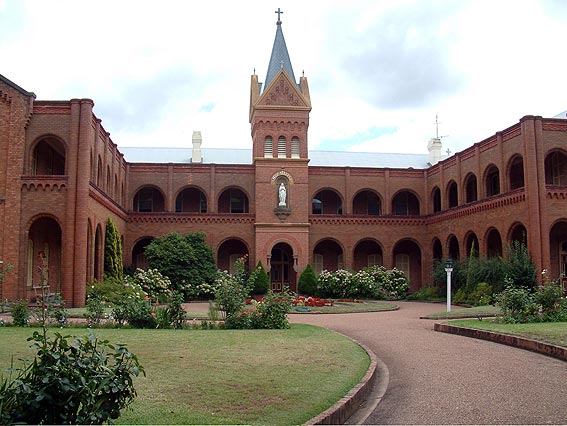
© PdL 2005
Historical and Technical Documentation by Pastór de Lasala
© OHTA 2005 (last updated October 2005)
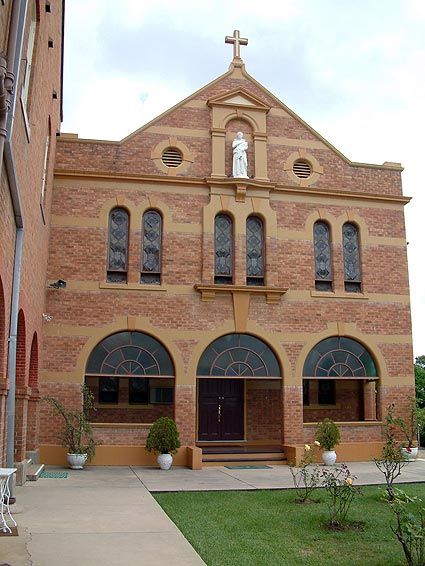
© PdL 2005
The entire complex is an impressive one. It measures 10 hectares and is a testimony to generations of Mercy nuns who looked after the site. On the left side of the convent, just as one enters the grounds, is the church of St Patrick with its sturdy twin towers. On the other side is the college of St Catherine. The main convent building is of two stories with arcaded balconies on three sides. These three edifices are all heritage buildings. Expansive gardens at the front add beauty to this magnificent monument. As one comes down the central path the entrance is dominated by a tower, capped with a short spire. The grandeur of this convent building is a contrast to the diminutive 19th century house - also in the grounds - where the first community lived. [1]
The chapel, in the shape of a Tau cross, is the jewel in the crown, of this 10 hectare complex. The very spacious and uncluttered interior features a fine sanctuary with major paintings either side of the high altar, collegiate style pews and, in the gallery, a barrel-vaulted ceiling and an organ with components made by J. Wheildon.
[2]
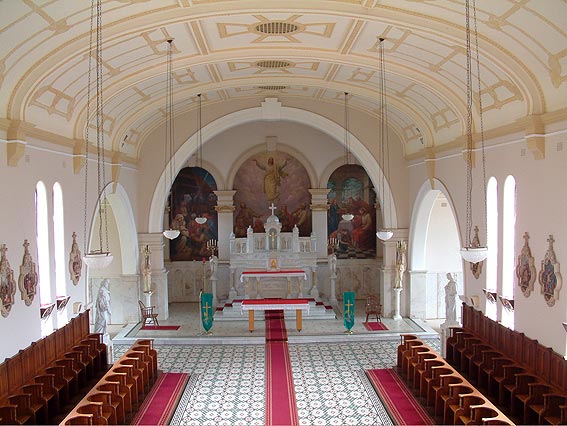
© PdL 2005
The organ is very neatly placed against the rear wall and between two windows sensibly covered by wooden blinds. The façade pipes are all gilt wooden dummies and are arranged in two towers of five and three pipes from the outside, and a central flat of eleven pipes ie 5-3-11-3-5. The keyboard is completely hidden from view behind a hinged panel which is fastened at the top. This feature is typical of 18th and early 19th century English chamber organs, and examples of the latter may be found in Tasmania and rural New South Wales. On folding down the panel, the keyboard is slid out in its position for playing.
[3]
On either side of the keyboard are five stop knobs in vertical formation. These have square shanks and beautifully reconstructed copperplate lettering. The footage of each rank is not displayed, being in keeping with historic practice. The keyboard has rather shallow sharp keys in ebony. The key cheeks are elegantly carved. This important instrument was restored by Pipe Organ Reconstructions Ltd in 1998. The consultant for the restoration was Ray Holland.
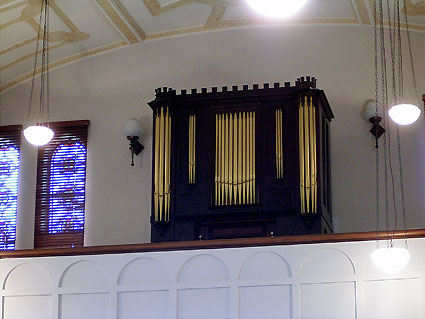
Builder unknown. Made from components of J. Wheildon c.1850 (1/5 mechanical)
The left jamb reads (from top to bottom):
| Octave Coupler Fifteenth Bass Flute Bass Principal Bass Stop Diapason Bass |
(C - B) (C - B) (C - B) (C - B) |
The right jamb reads (from top to bottom):
| Fifteenth Flute Clarabella Principal Open Diapason |
(C0 - f3) (C0 - f3) (C0 - f3) (C0 - f3) |
Mechanical action
Compass 54/25 (including pedal pulldowns)
[4]
Three composition pedals
Hitch-down swell pedal
No of pipes = 258
Pitch a1 = 445.5 Hz at 180 C
Wind pressure (in 1983) = 70 mm (2 ¾’’)
[5]
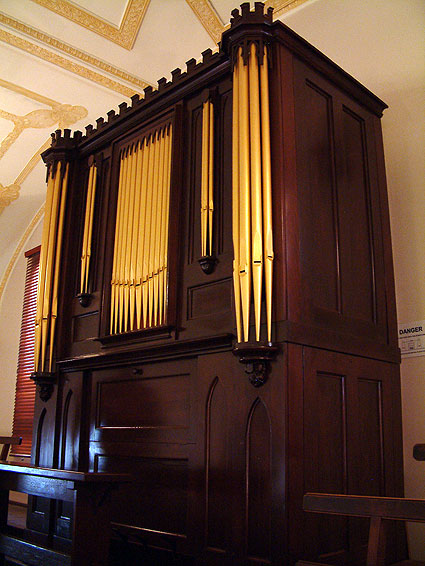
© PdL 2005

© PdL 2005
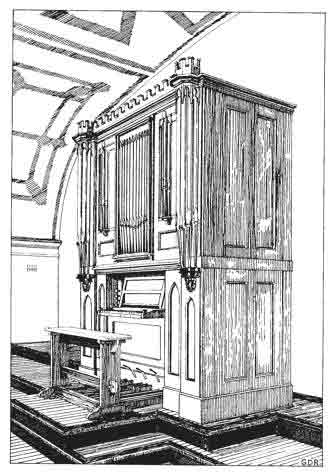
Organ by unknown builder
Chapel of the Convent of Mercy, Singleton
(drawing by Graeme Rushworth)
[1]
Pastór de Lasala, “Two Convent Organs in the Hunter Valley”, OHTA News, 29/1 (January 2005), 16-18.
[2]
This name was found stamped on the top F key. Since there were two J. Wheildons – father (1781 – ca. 1845) and son (1808 – 1859), it is not certain which of the two worked on the organ. cf monograph by G.D. Rushworth, R. Holland, M. Sinclair “The Pipe Organ, Convent of Mercy, Singleton”, 1998, 8.
[3]
Reconstructed during restoration. cf monograph by G.D. Rushworth, R. Holland, M. Sinclair “The Pipe Organ, Convent of Mercy, Singleton”, 1998 , 13.
[4] Non-original. cf monograph by G.D. Rushworth et al. op. cit p. 13
[5]
John Stiller, “Convent of Mercy Singleton - Detailed Documentation of Pipe Organ installed 1925”. Organ Historical Trust of Australia, 7 June 1983.